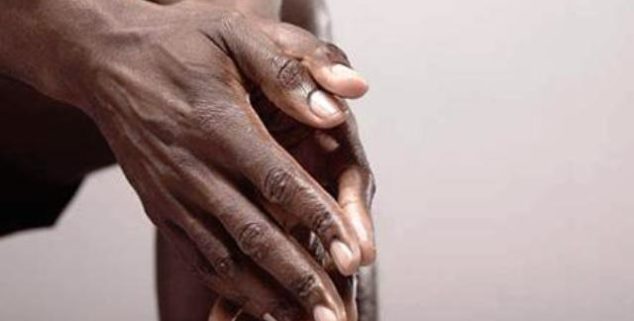Opinion
Health care: Sickle cell disease strikes hard at people of color
 The hands of a man suffering from sickle cell disease, or SCD.(Image: Sickle Cell Disease Emergency Department, Duke University.)
The hands of a man suffering from sickle cell disease, or SCD.(Image: Sickle Cell Disease Emergency Department, Duke University.)Growing up in Nigeria meant living in the shadow of sickle cell disease (SCD). In 2010, an estimated 90,000 newborns in Nigeria had sickle cell anemia – the highest incidence of SCD worldwide.
I vividly remember being about 10 years old and the pain of learning why my neighborhood friend had stopped coming over to play. I had to explain to my younger sisters that our friend had died from complications of SCD.
There are an estimated 9,000 people living with sickle cell disease in California, an inherited blood disorder.
A few years later, one of my classmates, who also had SCD, stopped coming to school. I feared the worst, but she returned several weeks later. But she was visibly different, dragging her right side and speaking in garbled sentences. I later learned that she had been paralyzed by stroke, a common occurrence for children with severe SCD. She could no longer use her right hand, but I remember laying my left hand over hers as she learned to write again.
I didn’t know this then, but her resilience and determination to live left an indelible mark on me.
Treating SCD is personal to me. Caring for adults with SCD stems from my desire to serve this vulnerable patient population, many of whom live with severe chronic pain and face immense psychosocial stressors in their pursuit of equitable health care.
I work diligently to gain my patients’ trust because many have been traumatized by a racially biased health care system that invalidates their pain and unfairly labels them as “drug-seeking” or “difficult.”
There are an estimated 9,000 people living with SCD in California. This inherited blood disorder, which affects the shape of red blood cells and causes them to slow or block blood flow, primarily affects people from the Black community.
In 2019, two-thirds of California adults living with SCD could not even access a specialist to treat their disease.
SCD is also found in other communities of color with Latino, Middle Eastern, and South Asian ancestry. Periodic episodes of extreme pain, colloquially called “sickle cell crises,” are the major symptoms of SCD and the primary reason people seek medical care.
In the absence of quality care, unpredictable pain crises and other complications in these underserved communities frequently led to emergency room visits and hospitalizations at an estimated cost of $2.4 billion annually. And the cost to patients in lost quality of life, inability to work, and premature, preventable deaths is immeasurable.
In 2019, when two-thirds of California adults living with SCD could not even access a specialist to treat their disease, Assemblymember Mike Gipson (D-Carson) introduced a first-of-its-kind legislation to combat this untenable situation. AB 1105 (Gipson) proposed building a network of adult SCD clinics throughout California to improve access to care and expand the healthcare workforce of knowledgeable providers.
The bill allocates significant resources toward a statewide public health surveillance system to better understand the number of California adults living with the disease, their health and health outcomes, and their challenges in accessing quality care. The legislation passed and was included in Gov. Gavin Newsom’s 2019 Budget Act, securing $15 million to improve access to comprehensive SCD care by creating Networking California for Sickle Cell Care (Network).
With a plan and funding in hand, the Network, led by the Center for Inherited Blood Disorders in partnership with the Sickle Cell Disease Foundation, got to work.
In its first two years of a three-year initiative, the Network surpassed its goal of creating five SCD clinics, opening 10 throughout the state, including one at UC Davis Health, where I’m a practicing adult hematologist. I can’t tell you how happy I was to find out that this type of funding put toward socially responsible clinical care was coming to our clinic and that I was fortunate enough to be one of its leaders.
As a result of the Network’s efforts, thousands of Californians living with SCD are finally receiving the care they deserve, emergency room and hospital visits for SCD have significantly decreased, and more than $1 million in SCD care dollars have been saved thus far. California, once lagging behind the country in SCD care, is now viewed as a model for specialized care, thanks to the laser-focused mission of the Network.
To ensure we do not return to abysmal days where adults with this inherited disease were met with racism and stigma, patients, health care providers, community health workers and policymakers must continue working together.
Ensuring that this specialized, comprehensive care that is finally available to thousands of long-neglected Californians continues and expands is a moral imperative.
—
Editor’s Note: Dr. Oyebimpe Oluyemisi Adesina is a hematologist at UC Davis Health, and leads the region’s first and only specialized adult sickle cell disease clinic. Her views in this commentary are her own and do not represent the University of California.
Want to see more stories like this? Sign up for The Roundup, the free daily newsletter about California politics from the editors of Capitol Weekly. Stay up to date on the news you need to know.
Sign up below, then look for a confirmation email in your inbox.

Leave a Reply